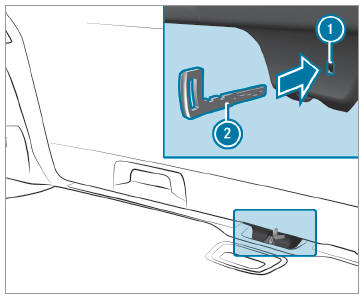Mercedes-Benz GLC 2016-2025 Owners Manual / Maintenance and care / Cleaning and care / Notes on using a power washer
Mercedes-Benz GLC : Cleaning and care / Notes on using a power washer
WARNING Risk of an accident when using power washers with round-spray nozzles
The water jet can cause externally invisible damage.
Components damaged in this way may unexpectedly fail.
 Do not use a power washer
with roundspray
nozzles.
Do not use a power washer
with roundspray
nozzles.
 Have damaged tires or
chassis parts
replaced immediately.
Have damaged tires or
chassis parts
replaced immediately.
To avoid damage to your vehicle, observe the following when using a power washer:
- The SmartKey is at a minimum distance of 10 ft (3 m) away from the vehicle. Otherwise the tailgate could open unintentionally.
- Maintain a distance of at least 11.8 in (30 cm) to the vehicle.
- Vehicles with decorative foil: parts of your vehicle are covered with a decorative foil. Maintain a distance of at least 27.6 in (70 cm) between the foil-covered parts of the vehicle and the nozzle of the power washer. Move the power washer nozzle around whilst cleaning. The water temperature of the power washer must not exceed 140°F (60°C).
- Observe the information on the correct distance in the equipment manufacturer's operating instructions.
- Do not direct the nozzle of the power washer directly at sensitive parts, e.g. tires, gaps, electrical components, batteries, light sources and ventilation slits.
 Notes on washing the vehicle in a car wash
Notes on washing the vehicle in a car wash
WARNING Risk of accident due to
reduced braking effect after washing the
vehicle
The braking effect is reduced after washing
the vehicle.
After the vehicle has
been washed,
brake carefully while paying attention to
the traffic conditions until the braking
effect has been fully restored...
 Washing the vehicle by hand
Washing the vehicle by hand
NOTE Engine damage due to water
ingress
Take care not to point
the water jet
directly towards the air inlet grille below
the hood.
Observe the legal requirements, e...
Other information:
Mercedes-Benz GLC 2016-2025 Owners Manual: Fuel
Notes on fuel grades for vehicles with gasoline engines Observe the notes on operating fluids. NOTE Damage caused by the wrong fuel Even small amounts of the wrong fuel could result in damage to the fuel system, the engine and the emission control system...
Mercedes-Benz GLC 2016-2025 Owners Manual: Replacing the 12 V battery
Observe the notes on the 12 V battery. Mercedes-Benz recommends that you have the 12 V battery replaced at a qualified specialist workshop, e.g. at an authorized Mercedes-Benz Center. Observe the following notes if you want to replace the battery yourself: Always replace a faulty battery with a battery which meets the specific vehicle requirements...
Copyright © 2025 www.meglc.net

